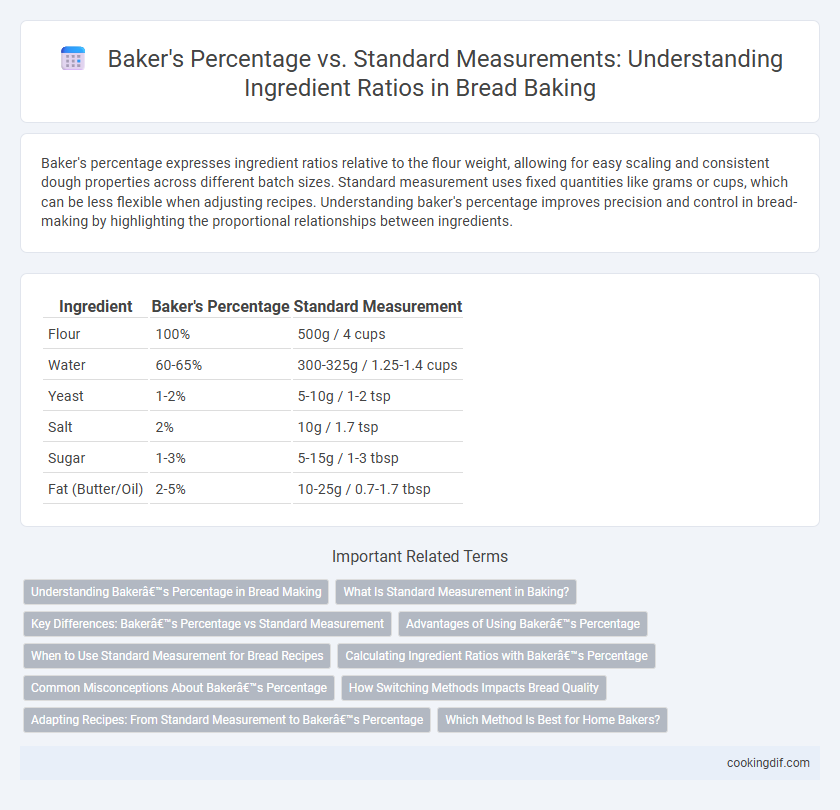Baker's percentage expresses ingredient ratios relative to the flour weight, allowing for easy scaling and consistent dough properties across different batch sizes. Standard measurement uses fixed quantities like grams or cups, which can be less flexible when adjusting recipes. Understanding baker's percentage improves precision and control in bread-making by highlighting the proportional relationships between ingredients.
Table of Comparison
| Ingredient | Baker's Percentage | Standard Measurement |
|---|---|---|
| Flour | 100% | 500g / 4 cups |
| Water | 60-65% | 300-325g / 1.25-1.4 cups |
| Yeast | 1-2% | 5-10g / 1-2 tsp |
| Salt | 2% | 10g / 1.7 tsp |
| Sugar | 1-3% | 5-15g / 1-3 tbsp |
| Fat (Butter/Oil) | 2-5% | 10-25g / 0.7-1.7 tbsp |
Understanding Baker’s Percentage in Bread Making
Baker's Percentage expresses ingredient ratios relative to the flour weight, with flour always set at 100%, allowing precise control over dough consistency and hydration in bread making. This system simplifies scaling recipes up or down, ensuring consistent texture and rise by adjusting water, yeast, salt, and other components proportionally. Understanding baker's percentage is crucial for professional bakers to achieve balanced fermentation, optimal crumb structure, and predictable baking outcomes.
What Is Standard Measurement in Baking?
Standard measurement in baking refers to using fixed units like grams, cups, or ounces to quantify ingredients, ensuring consistent results in bread recipes. Unlike baker's percentage, which expresses ingredient ratios relative to flour weight, standard measurement provides precise, absolute quantities essential for replicability. This method simplifies following recipes for home bakers by clearly defining the exact amount of each component needed.
Key Differences: Baker’s Percentage vs Standard Measurement
Baker's Percentage expresses each ingredient as a percentage of the flour weight, enabling easy recipe scaling and consistent dough hydration control. Standard Measurement uses fixed units like grams or cups, which can vary in accuracy and are less adaptable for adjusting batch sizes. The key difference lies in baker's percentage providing relative proportions for precision and flexibility, while standard measurement offers absolute quantities that may require conversion for scaling.
Advantages of Using Baker’s Percentage
Baker's Percentage simplifies ingredient scaling by expressing each ingredient as a percentage of the flour weight, ensuring consistent dough hydration and texture across different batch sizes. This method enhances recipe accuracy, allowing bakers to easily adjust quantities without altering the bread's structural balance. Standard measurement often leads to inconsistent results, whereas baker's percentage maintains proportional relationships critical for achieving optimal dough performance.
When to Use Standard Measurement for Bread Recipes
Standard measurement is ideal for home bakers who prefer precise and easy-to-follow ingredient quantities, especially when baking small batches or using volume-based tools like measuring cups and spoons. It ensures consistency in recipes without requiring conversion or deep understanding of flour's weight percentages. Bread recipes with simple ingredient lists and those designed for beginners benefit most from standard measurement.
Calculating Ingredient Ratios with Baker’s Percentage
Baker's percentage calculates ingredient ratios based on the flour weight, assigning flour as 100% to standardize measurements and simplify scaling of bread recipes. Each ingredient's weight is expressed as a percentage of the total flour weight, allowing precise proportional adjustments regardless of batch size. This method enhances consistency in dough hydration, yeast, salt, and other ingredients, optimizing texture and flavor in bread baking.
Common Misconceptions About Baker’s Percentage
Baker's percentage is often misunderstood as a way to measure by weight rather than volume, but it specifically expresses ingredients as a percentage of flour weight, ensuring consistent dough hydration and texture. Many mistakenly apply standard measurement ratios directly to baker's percentage formulas, which can lead to incorrect ingredient proportions and inconsistent baking results. Accurate use of baker's percentage allows bakers to easily scale recipes while maintaining the precise balance of flour, water, yeast, and salt crucial for high-quality bread.
How Switching Methods Impacts Bread Quality
Baker's Percentage calculates ingredient ratios based on the flour weight, enhancing consistency and scalability in bread recipes by adjusting proportions relative to the main ingredient. Standard Measurement uses fixed quantities, which can lead to variations in dough hydration and texture when scaling recipes. Switching from standard measurement to baker's percentage improves dough consistency, fermentation control, and ultimately results in higher quality bread with predictable crumb structure and crust.
Adapting Recipes: From Standard Measurement to Baker’s Percentage
Adapting bread recipes from standard measurement to baker's percentage allows bakers to scale ingredients relative to the total flour weight, enhancing recipe flexibility and consistency. Baker's percentage expresses each ingredient as a proportion of flour, enabling precise adjustments for hydration, yeast, and salt levels based on dough requirements. This method streamlines ingredient scaling, minimizes measurement errors, and improves repeatability in bread-making processes.
Which Method Is Best for Home Bakers?
Baker's percentage offers a precise way for home bakers to scale recipes by expressing each ingredient as a percentage of flour weight, ensuring consistency regardless of batch size. Standard measurement uses fixed quantities like cups or grams, which can lead to variability when adjusting recipes. For home bakers seeking accuracy and flexibility, baker's percentage is the superior method, especially when experimenting with hydration levels and ingredient ratios.
Baker’s Percentage vs Standard Measurement for ingredient ratios Infographic

 cookingdif.com
cookingdif.com